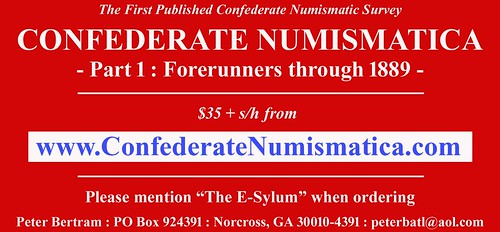
PREV ARTICLE
NEXT ARTICLE
FULL ISSUE
PREV FULL ISSUE
THE 1917-1919 SUSPENSION OF U.S. GOLD COINSRegarding my question about the "plan to take the gold piece out of circulation" mentioned in the 1917 newspaper article quoted last week, Kent Whiting writes: According to David Lange in his NGC column on the Coins of 1916 part 3, Congress changed the gold coin reserve requirement for backing gold certificates from 2/3 to 1/3 the amount of notes outstanding. The 1/3 reserve could be met by existing gold coins in Treasury vaults. With the exception of the western states, gold did not circulate at the time and was only used for gold certificate reserves. Therefore it was determined that no new mintage of gold coins was required. So far I have been unable to find reference to this decision in the mint reports or annual reports of the Secretary of the Treasury. Mintage of gold coins did not resume until 1920. I assume this is the “plan” they were referring to?
To read the complete article, see:
Dave Lange submitted these extensive notes on the subject. Long story short, the result was a short suspension of gold coin production, not an actual permanent halt.
-Editor
Regarding your question about the withdrawal of gold coins in 1917, this was well known to me from my reading of various sources. My interest in the subject was prompted by the glaring suspension of United States gold coin production during 1917-19, years in which the only gold coin struck was the non-circulating 1917 McKinley Memorial Gold Dollar. The onset of World War I in 1914 quickly led to fluctuations in precious metals prices, hoarding and inflation. As a result, nearly all countries then on the gold standard suspended it until further notice, this going into effect by the end of 1915. The USA was somewhat insulated from the war's effects, but it finally succumbed to economic pressure by suspending the production and circulation of gold coins for the war's duration, while still retaining the gold standard until 1933. This policy went into effect in March of 1917, as was anticipated in the newspaper article you reproduced. Also largely removed from circulation were gold certificate notes, these being replaced with Federal Reserve Notes. I found a good account in the book A Monetary History of the United States 1867-1960, by Milton Friedberg and Anna Jacobson Schwartz. It includes a quote from another reference that largely explains the situation: "The withdrawal of over $1 billion of gold coin and certificates from circulation was effected as part of the policy of concentrating gold in the Federal Reserve System and was achieved by asking the banks to cooperate by 'sorting out of your incoming cash the gold certificates, not paying out any such certificates over your counter unless especially requested, but instead, forwarding to this bank [New York Federal Reserve] all you may accumulate in excess of those you think it advisable to carry as part of your vault money.' The banks were asked to pay out Federal Reserve notes, instead, and the public was discouraged from requesting gold coins for gifts." Giving out gold coins at holidays and birthdays was a longstanding tradition, gold dollars being used in the period when they were current, and quarter eagles being used in later years. I have several examples of small envelopes from the 1890s - 1920s that were specifically designed to hold a quarter eagle and printed with text indicating that it was a gift. Given the circumstances of gold coin withdrawal, westerners had no choice but to accept paper currency in its place. Under the Pittman Act of 1918, silver certificates were likewise withdrawn and replaced with Federal Reserve Notes, millions of silver dollars then being freed up for melting. With the price of silver rising rapidly during the war, finally exceeding the melt value of silver dollars by 1920, these coins temporarily became scarce in the West, too. The price of silver fell toward the end of 1920, the melted silver dollars were replaced starting the following year, and that crisis passed. The minting of gold coins resumed in a limited manner in 1920, but most of these were never released to domestic circulation. Large numbers went overseas, only to be repatriated after World War II for the benefit of collectors, but millions were never issued and succumbed to mass melting in 1936-37. This accounts for the many rare dates among high mintage issues of the 1920-33 years.
Thanks for clearing this up!
-Editor
To read the earlier E-Sylum article, see:

Wayne Homren, Editor The Numismatic Bibliomania Society is a non-profit organization promoting numismatic literature. See our web site at coinbooks.org. To submit items for publication in The E-Sylum, write to the Editor at this address: whomren@gmail.com To subscribe go to: https://my.binhost.com/lists/listinfo/esylum All Rights Reserved. NBS Home Page Contact the NBS webmaster 
|